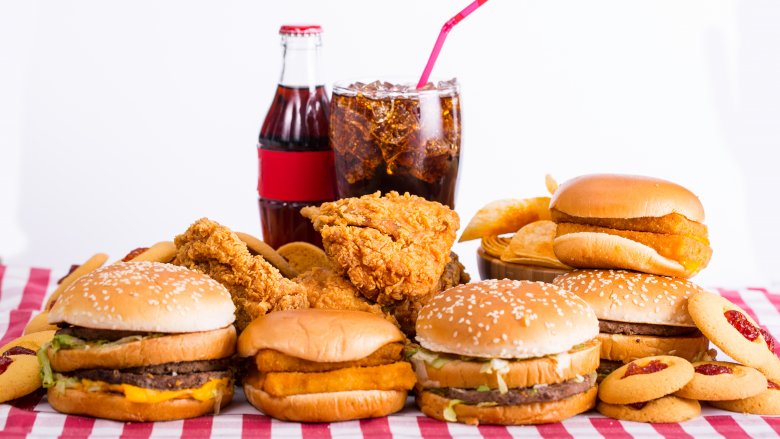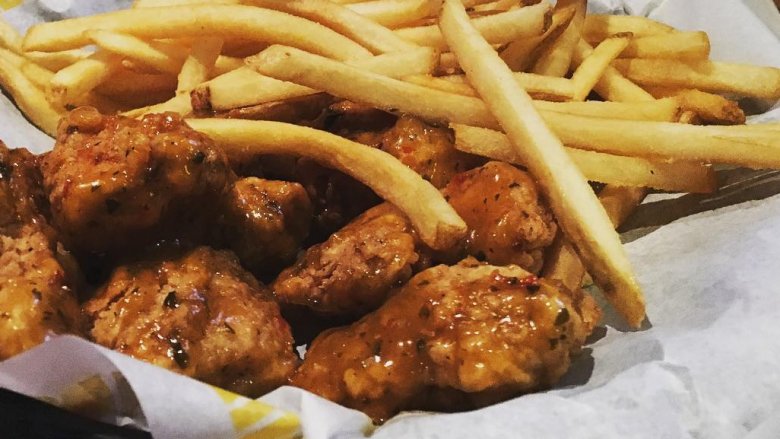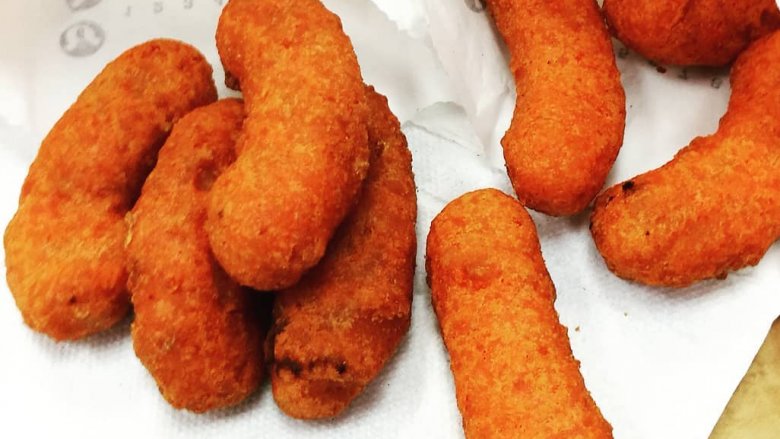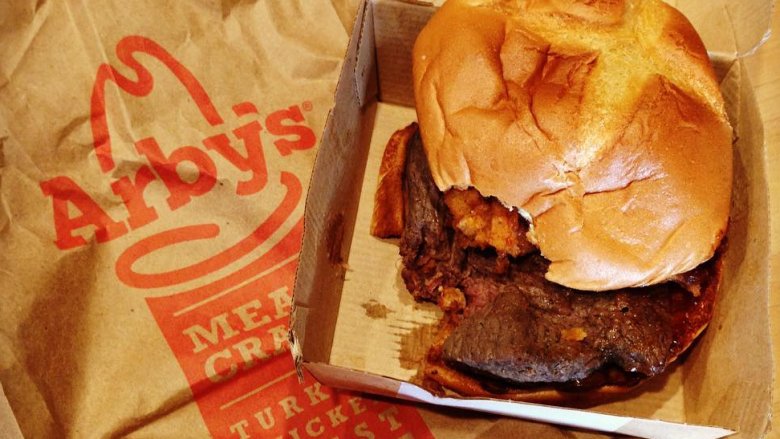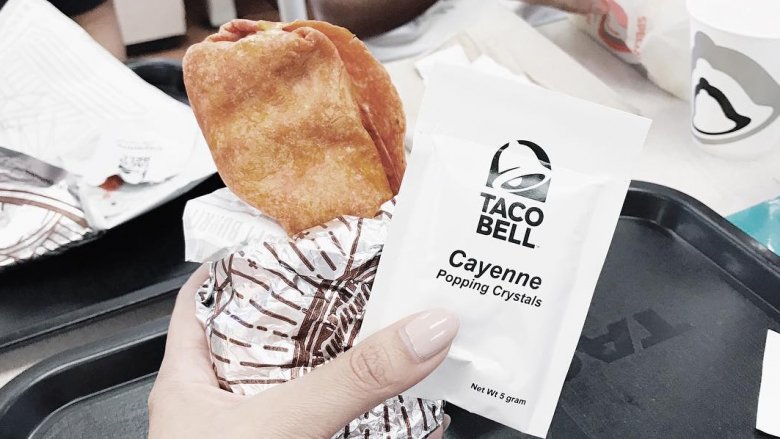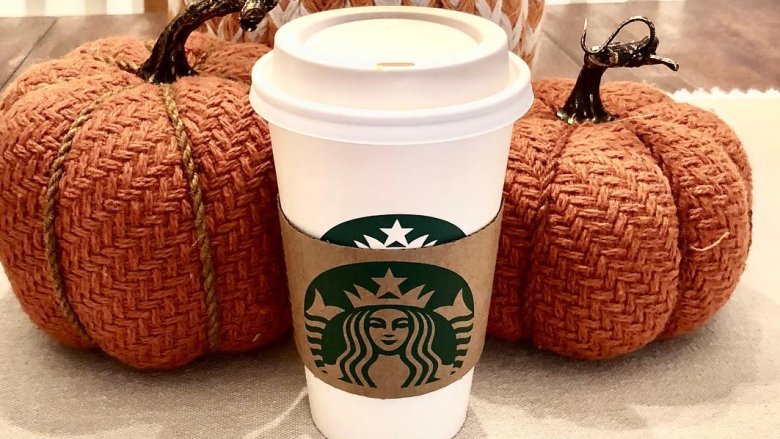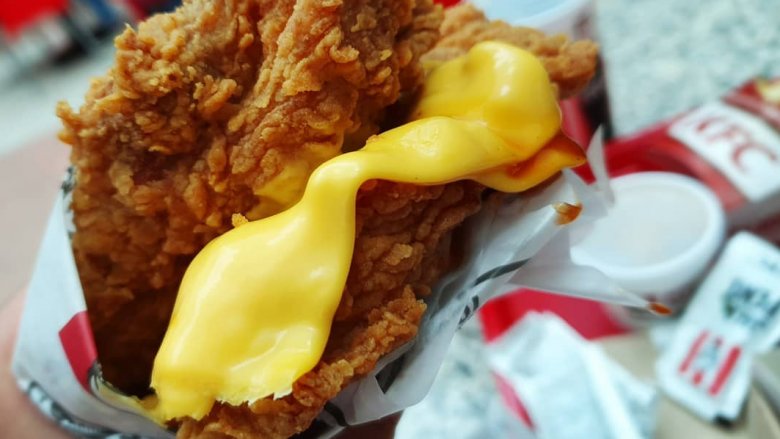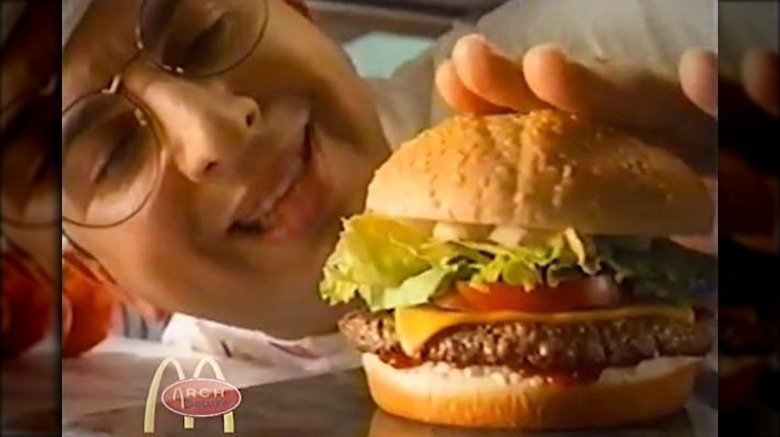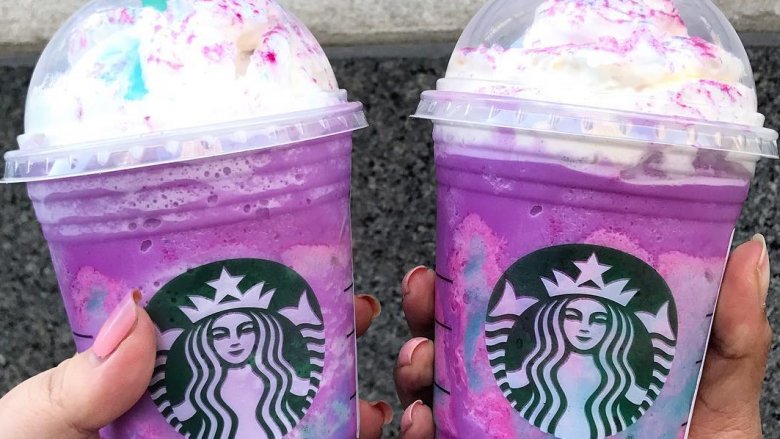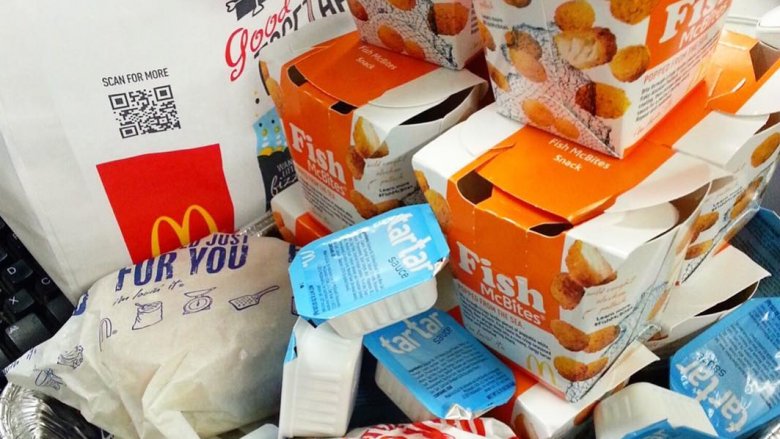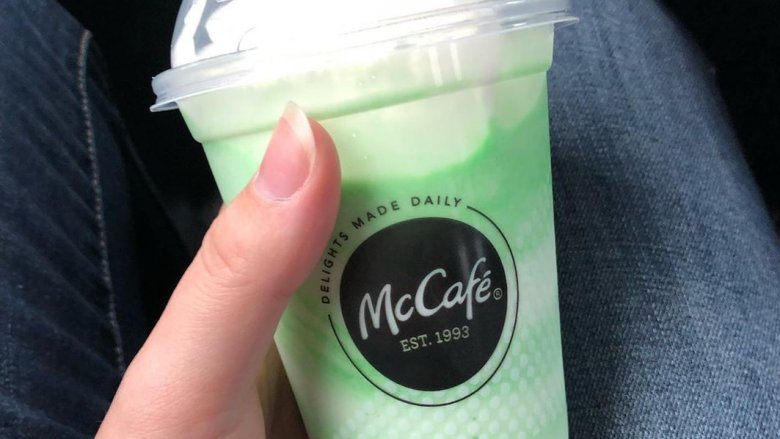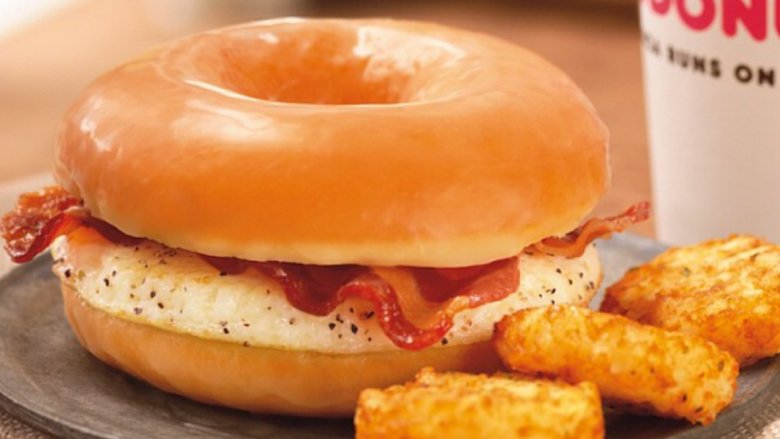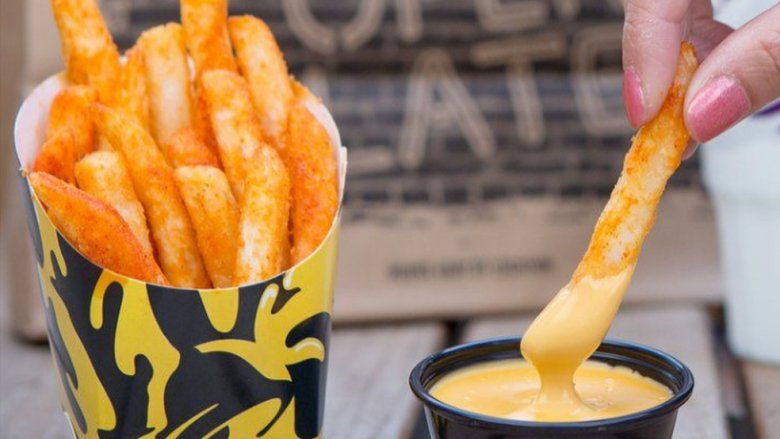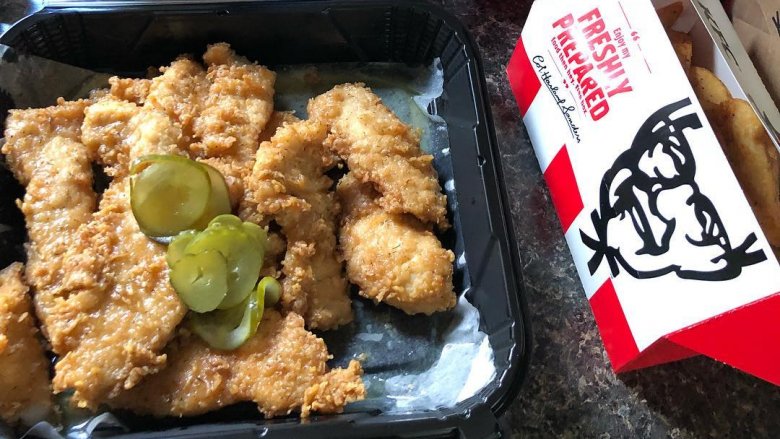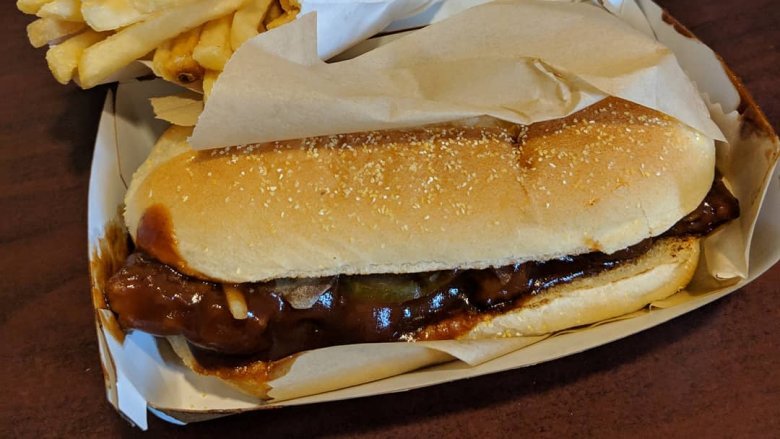Limited Edition Fast Food Menu Items, From Worst To Best
In the last decade, it seems like the "limited time offering" wars between fast food restaurants have achieved staggering new levels of outrageousness. Every few weeks, a new product will be announced, offering previously unheard of (and infinitely Instagrammable) levels of drive-thru excess, from tacos made out of chicken, to overstuffed sandwiches piled high with four different kinds of meat, to nachos made out of french fries.
The race among fast food companies to outdo each other with increasingly crazy limited time offerings has translated into big business. Since 2015, the number of limited-time menu items has increased 64 percent at Top 500 chain restaurants and retail operations. According to a report by Restaurant Business Online, fast food brands comb through thousands of ideas for new limited time offerings each year.
But for every new limited time offering that drives sales and social media buzz, there are others that are dismal failures. Join us, as we take a look at the history of limited edition fast food meals, ranked from worst to best.
Buffalo Wild Wings Mountain Dew Wings
In what must have seemed like a dream come true to legions of 13-year-old boys nationwide, Buffalo Wild Wings rolled out a limited time offer in 2015 that combined two perennial prepubescent favorites: Chicken wings and Mountain Dew.
In a collaboration that only those with a true sense of dietary self-loathing could appreciate, Buffalo Wild Wings doused its signature fried chicken wings in a mix of Mountain Dew, lemongrass, ginger, soy sauce, and red peppers.
After the initial shock and awe in the fast food community, the reviewers weren't particularly kind. A reviewer for The Huffington Post at the time noted, "You can literally taste the Mountain Dew aftertaste in the sauce. It kinda burns your throat in that artificial soda way. The sauce starts out sweet and then gets a little spicy, finishing with a weird artificial lime-y flavor."
The lesson? When dreaming up your brand's next limited time offering, "Whatever, just add some Mountain Dew to it" isn't a viable strategy.
Burger King Mac n' Cheetos
You have to hand it to Burger King: On paper, deep-fried wads of macaroni and cheese doused in Cheeto dust and deep fried probably sounded like a great idea. But there have been few times in limited time offering fast food history when the gulf between "idea" and "finished product" has been so vast, and so disappointing.
First introduced in 2016 and then resuscitated for a second limited run in 2017, Burger King's Mac n' Cheetos never quite caught fire. If we can all agree that macaroni and cheese is delicious, and that Cheetos are delicious, then what could possibly have gone so horribly wrong with these bright orange, Cheetos-shaped chunks of cheese overload?
While the flavor wasn't terrible, most of the issues probably boil down to the unsettling texture of the dish, especially if you were unlucky enough to score a batch that had been sitting under the warming lamp for more than a few seconds. The combination of already-mushy, overcooked macaroni and cheese with a less-than-crisp Cheetos exterior proved unpleasant for many testers.
"These are bad. Very bad," said one taste tester at Business Insider. "There is no flavor, no crispiness, just a mushy center that vaguely resembles mac and cheese that's been run through a blender coated in something that looks like Cheetos and has also run through a blender."
Arby's Venison Sandwich
You know what you don't hear a lot of people clamoring for, at least outside of the Appalachians? Deer steak sandwiches. And yet, that's exactly what Arby's rolled out for just three days in 2016, and one day in 2017.
Initially available in just a handful of states, Arby's Venison Sandwich boasted a thick-cut venison steak and crispy onions with juniper berry sauce on a toasted roll. The venison steak was marinated in garlic, salt and pepper, and then cooked sous-vide style for three hours.
Though Arby's scored some positive press for its foray into exotic game meats, reviewers weren't as kind. According to The Philly Voice, the sandwich "had the consistency of a dog toy but without the squeak, or a peppery rubber deer tire." On Milwaukee took the criticism even further, explaining that the meat "was mushy and mealy — chewy and moist not in a good way but in a 'did somebody already gnaw on this and then put it between two buns?' way. And that's not even including the unappealing vein of translucent gummy fat..."
Mixed reviews notwithstanding, the stunt has been a success for Arby's; the chain sold out of the sandwich during its run in 2016 in a matter of hours, and the repeat performance in 2017 saw similar success. It just goes to show you: If you make your limited time offering weird and scarce enough, customers will clamor for it, no matter how it tastes.
Taco Bell Firecracker Burrito
In a pop culture product mashup that literally nobody asked for, the mad scientists at Taco Bell did the unthinkable in 2017. They added spicy Pop Rocks to a burrito.
Dubbed the Firecracker Burrito, the product started the way most menu items do at Taco Bell, with seasoned ground beef, rice, nacho cheese, crunchy tortilla strips, and reduced fat sour cream wrapped in a flour tortilla. But then. BUT THEN! Customers were urged to sprinkle the included packet of "cayenne popping crystals" into the mix, resulting in a burrito that literally exploded in your mouth when you ate it.
Though Taco Bell never referred to their secret add-on ingredient by name, the popping crystals are a clear relative of Pop Rocks, the carbon infused-popping candy that you probably haven't had since you were in the sixth grade.
It may have been gimmicky, but was it any good? The popping crystals added an interesting texture to the usual mishmash of sorta-Mexican ingredients Taco Bell uses in all of its food, and lent a sweet and spicy contrast. But you had to be careful in how you applied the popping crystals; eat too many at once and the burrito became overwhelmingly sweet, plus all of that popping tended to wreak havoc on your sinuses.
Starbucks Pumpkin Spice Latte
Don't worry; we're not going to spend the next few paragraphs harping on the evils of the Pumpkin Spice Latte. After all, the subject has been written about to death, by now. Hating on Pumpkin Spice Lattes has in itself become as basic as the people who drink them, and we're willing to lay the "controversy" to rest this way: If you like Pumpkin Spice Lattes, drink them proudly. If you don't, that's also fine.
Instead, we want to focus on the way this innocent limited time offering from Starbucks not only caught on like wildfire, but managed to create a national conversation; love them or hate them, you can't avoid a discussion about Pumpkin Spice Lattes every fall, when the company trots them out again. And after all, that's the goal of any limited time offering: To get you talking about the product, for better or for worse.
What makes the Pumpkin Spice Latte popular? Turns out, it's a carefully engineered "brain bomb." According to Wired, "The most important elements here are a heap of concentrated sugar, a bunch of warm, frothy milk fat, and a pinch of salt to get the dopamine flowing." The combination of all that saturated fat, sodium, and sugar, they say, causes "a reaction in your brain that mimics the rush from certain addictive drugs."
KFC Double Down
In April 2010, KFC announced a sandwich that would escalate the drive thru stunt-food wars to previously unheard of levels: The Double Down, a bunless fried chicken sandwich with bacon, white American cheese, a squeeze of Colonel's Sauce, and two boneless Original Recipe filets in place of buns.
The outcry from the Internet was swift; PETA was quick to brand the new chicken-sandwich-made-of-chicken the "vilest food product created by man," citing the sandwich's "quadruple cruelty" to animals. Legendary New York Times food reviewer Sam Sifton called the Double Down "a slimy and unnaturally moist thing, with flavor ginned up in a lab," and "a disgusting meal, a must-to-avoid." And a reviewer for Cracked found the sandwich to be "crisp, mildly tangy, a little messy and a harbinger of a blood soaked world of unrelenting pain... two stars."
Whether you admire the risk KFC took in bringing this offering to the masses, or regard it as an indicator of everything that's wrong with the fast food landscape in America, you have to hand it to the Double Down: It got us talking.
McDonald's Arch Deluxe
In the mid-'90s, McDonald's decided to try to update their image as a purveyor of dirt-cheap kids' food into something more sophisticated with the launch of the Arch Deluxe.
The new burger, touted in various marketing campaigns as "the burger with the grown up taste," was supposed to usher in a new generation of McDonald's consumers looking for a higher-quality burger. Served on a bakery-style star-cut potato-flour bun, the burger featured a fresh-cooked quarter pound of beef (which was not the norm for the chain at the time), topped with cheese, leaf lettuce, tomato, peppered bacon, and the chain's new "Arch Sauce," a mayo-and-mustard hybrid. McDonald's spent $150 million to $200 million on the Arch Deluxe (more than any other fast food marketing campaign at the time), and predicted sales of over $1 billion. Instead, the product was a flop with customers, and was pulled from menus in less than a year.
But could the Arch Deluxe simply have been ahead of its time? McDonald's is betting that the answer is "maybe." Now that customers have grown to expect fresher ingredients and more grown-up flavors, the company has been testing an updated version of the Arch Deluxe. Dubbed the "Archburger," the new version of one of McDonald's most legendary failures has the same potato-flour bun, plus a few of the same toppings: cheese, onion, pickle, and that famous "Arch Sauce." The other major difference? It's cheaper than the other items on the menu.
Starbucks Unicorn Frappuccino
It seems like Starbucks discovered the raw power of Instagram marketing back in 2017, creating a viral sensation with their photogenic Unicorn Frappuccino. According to a Starbucks news release (via The Washington Post), it was "made with a sweet dusting of pink powder blended into a crème Frappuccino with mango syrup, and layered with a pleasantly sour blue powder topping," and the drink changed from sweet to sour as you drank it, the colors swirling together in streams of blue and purple with each stir.
But it wasn't the absurd amounts of sugar and calories, or the unique taste of the drink (which one reviewer described as a mixture of "sour birthday cake and Instagram likes" and "a creamsicle dredged in Pixy Stix") that made it so notable. Instead, it's how Starbucks was able to leverage social media to explode images of the beverages onto everyone's phones nearly simultaneously. During the five day window of availability, there were nearly 155,000 Unicorn Frappuccino posts on Instagram, turning ordinary Starbucks customers into an unwitting marketing army.
McDonald's Fish McBites
The logic certainly seemed sound enough: Chicken McNuggets are nearly universally beloved, and the Filet o' Fish is arguably one of the finest sandwiches that McDonald's offers. So what could go wrong, using the magic McNugget machine to miniaturize fish into poppable bites of seawater-scented deliciousness?
McDonald's introduced Fish McBites in three sizes in 2013, each conveniently packaged to fit into your car's cup holder, so that consumers could finally live their unrealized dreams of "eating fish" and "driving cars" at the same time. The fish, sustainably-caught Alaskan Pollock, was flakey, tender, and moist, with a crunchy crumb coating. Most reviews at the time were positive; The Huffington Post called Fish McBites "one of the best items we've ever had from McDonald's," noting the pleasant flavor of the peppery breading and the firm texture of the fish itself.
Sadly, Fish McBites just weren't meant to be. McDonald's pulled the item from menus shortly after their debut, citing poor sales and lack of consumer interest.
McDonald's Shamrock Shake
We can't celebrate the annual rollout of the Shamrock Shake for what it is, because nobody knows what it is. Okay, that's not exactly true; McDonald's describes the unique green milkshake that's released each year to coincide with St. Patrick's Day as "creamy, dreamy vanilla soft serve blended with Shamrock Shake syrup and topped with delicious whipped topping." Helpful, sort of, but what exactly is the flavor of "Shamrock Syrup"?
Though "mint" seems to be one of the flavors, there's so much more going on inside a Shamrock Shake. It's almost overwhelmingly sweet, in that vague, creamy, cookie butter-y sort of way, with peppermint notes that are more like what you'd find in those butter mints sitting in a glass dish in the waiting area of a low-rent Chinese restaurant. The subtle mint flavor allows the creaminess of the vanilla base to shine through, resulting in a home run limited time offering for McDonald's; the chain has been serving its signature shake just one month a year for nearly 50 years.
Dunkin' Donuts Glazed Donut Breakfast Sandwich
In what seemed like a high crime against continued arterial function, Dunkin' Donuts rolled out a national limited time offering that seemed almost too good to be true: A breakfast sandwich that used a glazed donut for a bun.
Released in 2013 and no doubt inspired by Paula Deen's own experiments with glazed donuts stuffed with meat, the Dunkin' Donuts Glazed Donut Breakfast Sandwich featured a pepper fried egg and bacon, served steaming hot on a filleted glazed donut. The microwaved heat from the ingredients just barely liquefied the glaze on the donut, turning the whole sandwich into a sticky, sweet, and savory mashup that proved pretty irresistible.
While not exactly health food, the Glazed Donut Breakfast Sandwich wasn't even the worst thing on the Dunkin' Donuts menu; with a comparatively sane 360 calories and 20 grams of fat, it somehow managed to be better for you than the chain's staple Sausage Egg and Cheese Croissant, which packs 710 calories and 51 grams of fat.
Taco Bell Nacho Fries
Taco Bell Nacho Fries were seemingly EVERYWHERE in 2018, following a big marketing push from the chain to insert "cheese fries" into the national consciousness. A single dollar got you a container of the new seasoned fries, with a sidecar of nacho cheese sauce. There was also a "Supreme" version of the french fries, which added seasoned ground beef, diced tomatoes, and the chain's ever-present reduced fat sour cream for $2.49, and a "Bell Grande" version for just $3.49.
The fries themselves weren't anything Earth-shattering, and pretty similar to seasoned fries at other chains. It hardly mattered, though; once you poured on the included cheese sauce and a few dozen packets of Fire sauce, and Nacho Fries became an almost ridiculously inexpensive, mildly embarrassing, totally satisfying way to get all of Taco Bell's craving-inducing flavors into your empty stomach for just a buck.
Nacho Fries reappeared in 2019, only to be taken off the menu again early in the year. But fear not; Taco Bell seems to think it has a winner on its hands with this limited time offering, and we have a feeling we'll continue to see it trotted out on a regular basis.
KFC Pickle Fried Chicken
In 2016, KFC permanently altered its menu with the invention of a line of oil-based flavor sauces that packed huge wallops of flavor, while ensuring that their signature chicken remained crispy and crunchy. With the initial release of "Nashville Hot," followed shortly by "Georgia Gold," KFC had finally found a way to make their chicken taste like heavily-seasoned potato chips, without sacrificing texture.
In 2018, KFC took this new technology to the next logical place: By rolling out fried chicken that tasted like pickles. Available in bone-in chicken, tender, and sandwich varieties, the "Pickle Fried" chicken was topped with pickle slices and smothered in a pickle sauce. The sauce was made with dill, vinegar, onion, garlic, buttermilk, and white and black pepper, and it was, in a word, amazing. Business Insider hailed the extremely limited time offering as "a perfect pick for pickle lovers," which managed to "elevate a bizarre-sounding dish beyond a fast-food stunt."
Pickle Fried Chicken from KFC, we want you back.
McDonald's McRib
Introduced in 1982, the somehow boneless McRib sandwich wasn't a huge sales leader for McDonald's. As sales suffered, the sandwich was retired in 1985. It made limited reappearances throughout the 1990s, and each time, rumors would abound. Rumors that it was made of kangaroo meat. That it was only introduced seasonally, during the heady boom times of a pork surplus. But everyone could agree that it just wasn't very good.
Then, something brilliant happened. McDonald's encouraged the cultlike mystery of its sandwich to take root. It was very upfront about the fact that some people simply wouldn't like it. And with each limited time reintroduction, the marketing got a little smarter. The last time it was "officially retired", there was a "farewell tour" so that everyone could say goodbye.
Fast forward to today, and after 40 years, the sandwich still gets released once or twice a year to much hype and fanfare. Love it or hate it, you have to admire that kind of long-term marketing strategy.
